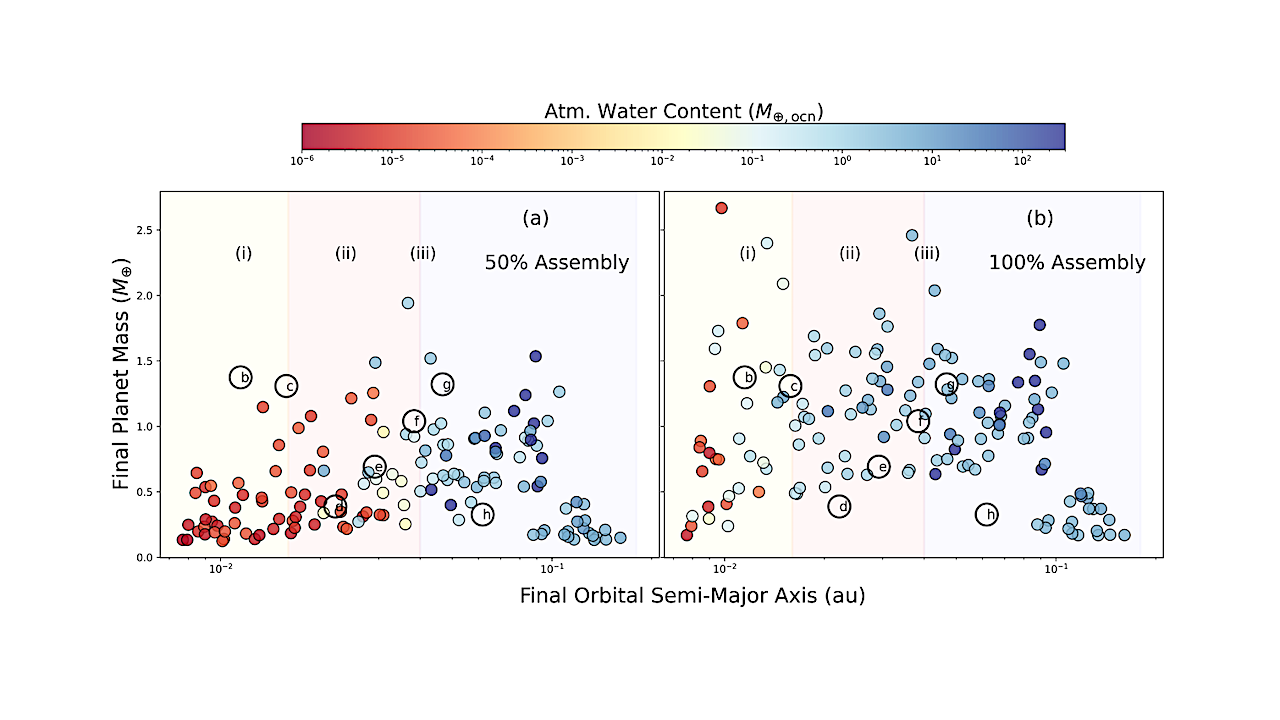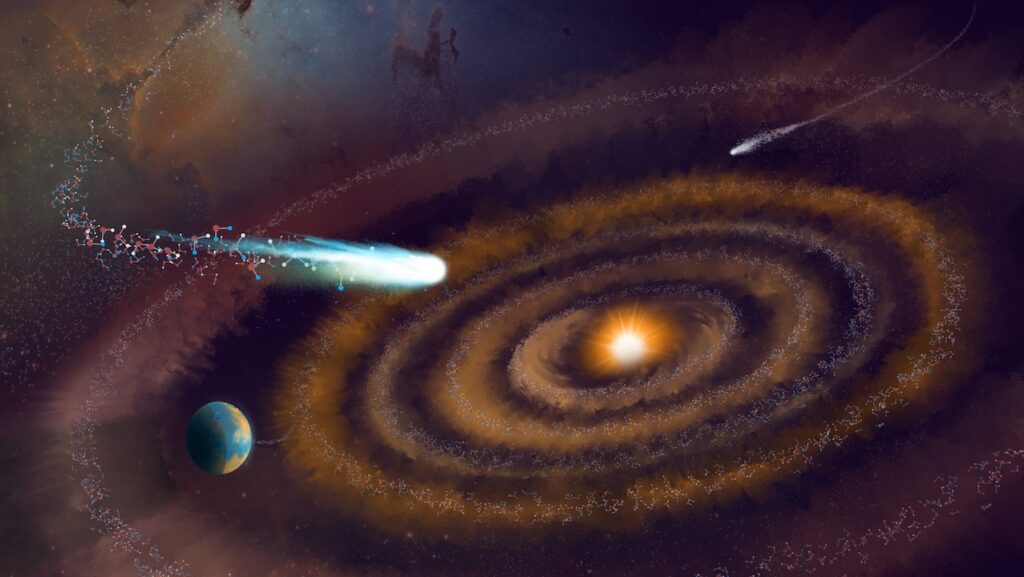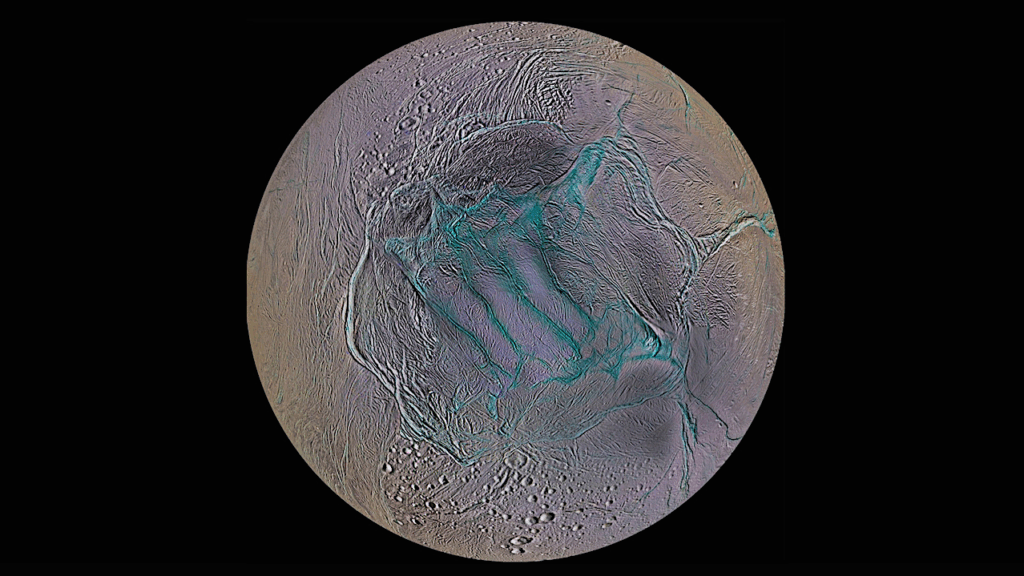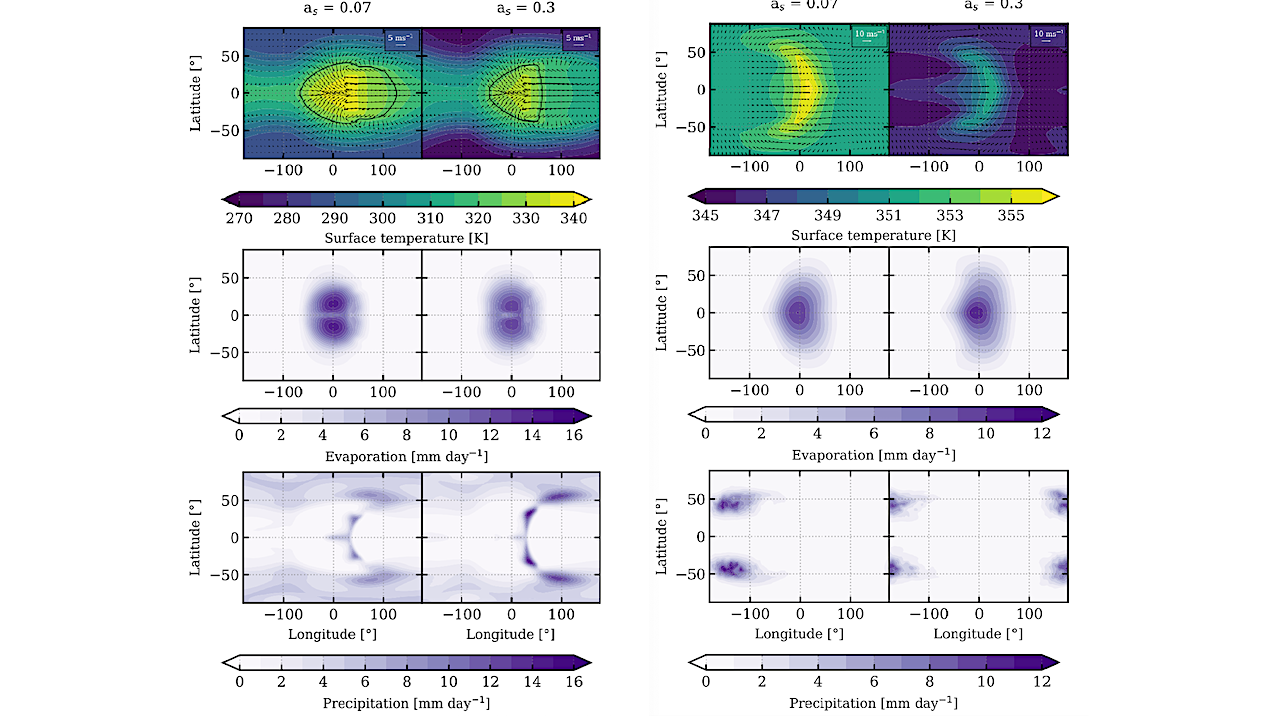Now Reading: Born Dry or Born Wet? A Palette of Water Growth Histories in TRAPPIST-1 Analogs and Compact Planetary Systems
-
01
Born Dry or Born Wet? A Palette of Water Growth Histories in TRAPPIST-1 Analogs and Compact Planetary Systems
Born Dry or Born Wet? A Palette of Water Growth Histories in TRAPPIST-1 Analogs and Compact Planetary Systems


Snapshots of VGS-calculated surface water mass (in units of Earth’s ocean mass) for TRAPPIST-1 analogs, shown as a function of total planet mass (M⊕) and final orbital distance (AU). Panel (a) depict planets at the halfway point of accretion (i.e., when the protoplanet reaches half its final mass), while panels (b) show the final planet properties. Measured properties of the TRAPPIST-1 planets are indicated by black circles (Agol et al. 2021). At mid-assembly, most inner planets are water-poor due to early impact-driven loss and higher irradiation. By the end of accretion, increased volatile delivery events from more water-rich materials and reduced erosion allow many planets, particularly beyond ∼0.03 AU,to accumulate and preserve large water reservoirs, leading to the strong radial gradient in water content. — astro-ph.EP
It is still unclear whether exoplanets in compact multiplanet systems such as TRAPPIST-1 are able to accrete large quantities of volatiles, grow to sufficient mass, and maintain robust atmospheres and hydrospheres.
Previous estimates of water content in M-dwarf systems have largely relied on population synthesis or atmosphere-interior evolution models, often treating impacts and atmospheric loss in isolation.
In this work, we couple impact delivery, impact erosion, and mantle-atmosphere exchange within a model that tracks volatile evolution through stochastic collision histories. By explicitly including both planetesimal accretion and the prolonged luminous pre-main-sequence phase of M dwarfs, we find lower water inventories for the inner TRAPPIST-1 analogs (b-e), spanning only 10−4-10−2M⊕,ocn across a wide range of disk structures and impact scenarios.
By contrast, the outer planets (f-h analogs) frequently retain water inventories exceeding an Earth ocean mass. This systematic volatile gradient provides a physically motivated explanation for JWST’s nondetections of atmospheres on TRAPPIST-1 b and c, implying an origin rooted in formation conditions rather than in post-formation escape.
Our results suggest that many rocky planets in compact M-dwarf systems may form already depleted in volatile compounds, fundamentally limiting their capacity to sustain atmospheres or surface oceans. More broadly, our multistage framework for volatile tracking can help interpret future observations of compact systems and set more realistic initial conditions for exoplanet interior compositions and atmospheric models.

Schematic of our modeling framework, illustrating the connection between N-body accretion outcomes and volatile growth simulations. Each panel highlights the primary physical processes represented at each stage of the model. Terrestrial planet formation begins with planetesimals and planetary embryos assumed to emerge from an initial gas+dust disk. Their subsequent growth is explicitly simulated using an N-body accretion model that incorporates processes such as collision fragmentation. The outputs from each collision event and accretion phase then serve as inputs to a self-consistent volatile growth model, which evolves key volatile species such as H2O, C, and N, based on cosmochemically informed initial compositions. Major processes contributing to volatile delivery and loss include impact erosion and mantle degassing. Roman numerals denote model sub-components: mantle (i), atmosphere (ii), core (iii), impactors (iv), and stellar EUV activity (v). Components (i)–(iii) constitute the three primary reservoirs of the growing protoplanet. The schematic layout is conceptually inspired by Gu et al. (2024). — astro-ph.EP
Howard Chen, Matthew S. Clement, Le-Chris Wang, Jesse T. Gu
Comments: 21 pages, 7 figures, 3 tables, published in the Astrophysical Journal Letters
Subjects: Earth and Planetary Astrophysics (astro-ph.EP)
Cite as: arXiv:2510.12794 [astro-ph.EP] (or arXiv:2510.12794v1 [astro-ph.EP] for this version)
https://doi.org/10.48550/arXiv.2510.12794
Focus to learn more
Journal reference: Chen, H., Clement, M. S., Wang, L. C., & Gu, J. T. 2025, ApJL, 991, L11
Related DOI:
https://doi.org/10.3847/2041-8213/adf282
Focus to learn more
Submission history
From: Howard Chen
[v1] Tue, 14 Oct 2025 17:58:32 UTC (6,254 KB)
https://arxiv.org/abs/2510.12794
Astrobiology, astrogeology,
Stay Informed With the Latest & Most Important News
Previous Post
Next Post
-
 012024 in Review: Highlights from NASA in Silicon Valley
012024 in Review: Highlights from NASA in Silicon Valley -
 02Panasonic Leica Summilux DG 15mm f/1.7 ASPH review
02Panasonic Leica Summilux DG 15mm f/1.7 ASPH review -
 03How New NASA, India Earth Satellite NISAR Will See Earth
03How New NASA, India Earth Satellite NISAR Will See Earth -
 04And Thus Begins A New Year For Life On Earth
04And Thus Begins A New Year For Life On Earth -
 05Astronomy Activation Ambassadors: A New Era
05Astronomy Activation Ambassadors: A New Era -
06SpaceX launch surge helps set new global launch record in 2024
-
 07Space Force plans new ‘Futures Command’ amid pressure to speed up modernization
07Space Force plans new ‘Futures Command’ amid pressure to speed up modernization




















